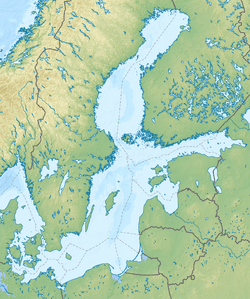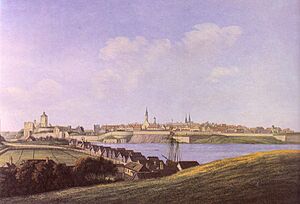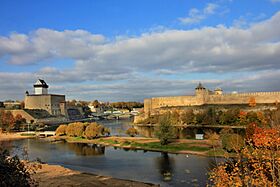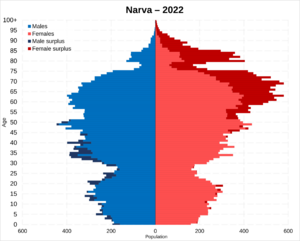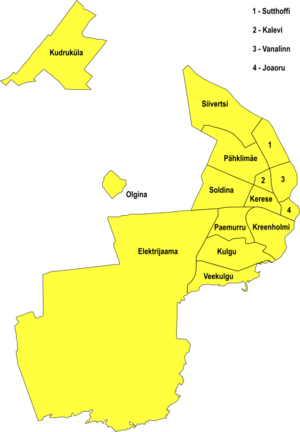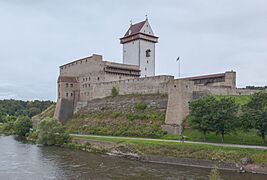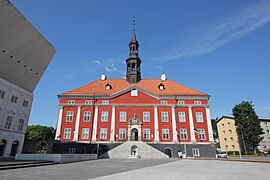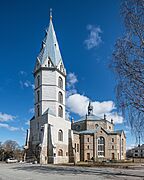Narva facts for kids
Quick facts for kids
Narva (Нарва)
|
|||
|---|---|---|---|
|
City
|
|||
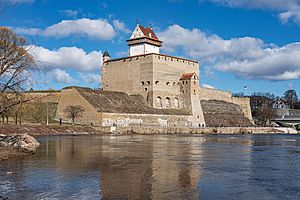
Narva's medieval Hermann Castle by the Narva river
|
|||
|
|||
| Country | |||
| County | |||
| First mentioned | 1172 | ||
| City rights | 1345 | ||
| Area | |||
| • Total | 84.54 km2 (32.63 sq mi) | ||
| Elevation | 25 m (82 ft) | ||
| Population
(2023)
|
|||
| • Total | 53,626 | ||
| • Rank | 3rd | ||
| • Density | 634.33/km2 (1,643.46/sq mi) | ||
| Ethnicity (2011) | |||
| • Russians | 87.7% | ||
| • Estonians | 5.2% | ||
| • other | 7.1% | ||
| Time zone | UTC+2 (EET) | ||
| • Summer (DST) | UTC+3 (EEST) | ||
| Postal code |
20001 to 21020
|
||
| Area code(s) | (+372) 035 | ||
| ISO 3166 code | EE-511 | ||
Narva is a city in Estonia. It is located in the Ida-Viru County, on the eastern edge of Estonia. The city sits on the west bank of the Narva river. This river forms the international border between Estonia and Russia. With about 53,626 people (as of 2023), Narva is Estonia's third largest city. Only Tallinn (the capital) and Tartu are bigger.
Narva was almost completely destroyed in 1944 during World War II. After the war, during the time Estonia was part of the Soviet Union (1944–1991), many of the city's original residents were not allowed to return. Instead, new workers from Soviet Russia and other parts of the Soviet Union moved in. Before the war, in 1934, about 65% of Narva's people were Estonian. After the war, most of the population became non-Estonian. Today, about 46.7% of the people in Narva are citizens of Estonia. About 36.3% are citizens of Russia, and 15.3% have undefined citizenship.
Contents
Narva's Past: A City Through Time
Early Days and First Mentions
People first lived in the Narva area a very long time ago, around 5,000 to 6,000 years ago. This is known from old tools and items found there. The oldest known fortified settlement in Estonia is in Narva, dating back to about 1000 BC. The name Narva first appeared in writing in 1172. It was in an old Russian record that mentioned a district called Nerevsky or Narovsky konets. This name likely came from the village or the Narva river itself. It suggests that Narva was on an important trade route.
Narva in the Middle Ages
Narva's good location, where trade routes met the Narva river, led to the building of Narva castle. A town grew around this castle. The castle was built when Denmark ruled northern Estonia in the late 1200s. The first written mention of the castle is from 1277. The village of Narvia was noted even earlier, in 1241.
The town around the castle became official in 1345. It received special "city rights" from the Danish king. In 1346, the Livonian Order took control of Narva after the Danish king sold his lands in northern Estonia. In 1492, the Ivangorod fortress was built across the Narva river by Ivan III of Moscow.
Trade was very important for Narva during the Middle Ages. However, Narva never joined the powerful Hanseatic League, a group of trading cities. It remained a small town. In 1530, it had only about 600–750 people.
Swedish and Russian Control
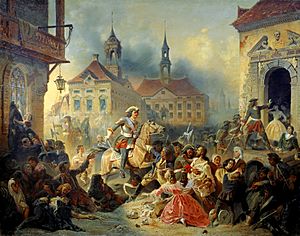
Narva was captured by Russia during the Livonian War (1558–1581). For a short time, it became a key port for Russian goods. In 1581, Swedish troops took the city, and it became part of Sweden.
During Swedish rule, Narva's beautiful Baroque Old Town was built. After a big fire in 1659, only stone buildings were allowed in the city center. Money from trade helped rebuild the town quickly. Until World War II, this Baroque Old Town stayed mostly the same. It was famous across Europe. The city's defenses were also greatly improved. A strong system of bastions was built around the town, designed by a famous military engineer. These defenses were among the strongest in Northern Europe.
Narva was the site of a major battle in the Great Northern War (1700–1721). In November 1700, Swedish forces, led by King Charles XII of Sweden, defeated a much larger Russian army. However, Russia later conquered the city in 1704.
After the war, Narva's defenses were fixed up. The city remained a military stronghold for the Russian Empire until 1863. From 1704 until 1917, Narva was part of the Saint Petersburg Governorate of the Russian Empire. This included its suburb, Ivangorod (Jaanilinn).
In the mid-1800s, Narva grew into a big industrial city. The Krenholm Manufacturing Company was founded in 1857. This factory used the power of the Narva waterfalls. By the end of the century, it was one of the largest cotton mills in Europe. It had about 10,000 workers. In 1872, Krenholm Manufacturing saw the first strike in Estonia. By the late 1800s, Narva was Estonia's top industrial town. About 41% of Estonia's factory workers were in Narva. The first railway in Estonia, built in 1870, connected Narva to Saint Petersburg and Tallinn.
After World War I
In July 1917, the people of Narva voted to join the new independent state of Estonia. Narva became part of the independent Republic of Estonia in 1918. The city saw fighting during the Estonian War of Independence. Russian Bolshevik troops attacked Narva on November 28, 1918. They held the city until January 19, 1919.
Narva was heavily damaged during World War II. The city was bombed by the Soviet Air Force in March 1944. This destroyed most of the beautiful Baroque old town. By the end of July 1944, 98% of Narva was destroyed. Most buildings could have been repaired, but Soviet authorities decided to tear down the ruins. They built new apartment buildings instead. Only three old town buildings remain, including the Town Hall.
Soviet Era (1944–1991)
After the war, the original residents were not allowed to return. Instead, Russian-speaking workers from other parts of the USSR moved in. Before the war, Estonians were the majority. After the war, the city became mostly non-Estonian. This was partly because there were plans to build a secret uranium factory in Narva. This would have made Narva a "closed town." Even though the factory was built in Sillamäe instead, the plan shaped Narva's growth. The factory plans and other large industries brought many new people from the Soviet Union, mainly Russia.
In January 1945, Jaanilinn, the suburb on the eastern bank of the river, was separated from Narva and Estonia. It became part of Russia. In 1954, Ivangorod became its own town.

Estonia Becomes Independent Again
When Estonia became independent again in 1991, some leaders in Narva wanted the city to have more control over itself. However, most people in the region did not want to break away from Estonia.
In 1993, there was a vote in Narva about becoming more independent. About 97% voted for it, but only 55% of people voted. There were also claims that the voting was not fair.
After 1991, there were some disagreements about the border between Estonia and Russia near Narva. Estonia's new constitution recognized the 1920 border. Russia, however, recognized the 1945 border. Estonia officially says it has no claims on the land. A new border treaty was signed in 2005 and again in 2014, but neither country has fully approved it.
By 2014, Russian residents in Narva were generally happy being citizens of both Estonia and the European Union. They lived peacefully with their neighbors. Before the 2022 Russian invasion of Ukraine, people crossed the border freely. Narva residents went to Ivangorod for cheaper goods. Russian residents came to Narva for things they couldn't get easily and for entertainment.
The war in Ukraine greatly reduced cooperation between the two sides. It became harder to get visas. More Narva residents started getting Estonian citizenship. Narva also welcomed many Ukrainian refugees. Estonian TV stations banned Russian TV channels that were popular with older Russian-speaking residents.
In June 2022, Estonia protested to Russia after President Vladimir Putin praised Peter the Great for taking Narva in the 1700s. In August 2022, a Soviet tank memorial was moved from Narva to a museum. In response, Russian authorities put up a similar tank monument in Ivangorod, near the border.
Narva's People: Demographics
As of January 1, 2013, Narva had 59,888 people. This was down from 83,000 in 1992. Most people in Narva (95.7%) speak Russian. About 87.7% are ethnic Russians. Most non-Estonians are from Russia, Belarus, or Ukraine. Many were born in Narva or have lived there for a long time. Only 5.2% of the population are ethnic Estonians.
As mentioned, Narva's population changed a lot after World War II. The Soviet authorities did not allow many pre-war residents to return. This changed the city's ethnic makeup. Before the war, in 1934, Estonians were the majority (64.8%). Russians were a significant minority (29.7%).
Today, 46.7% of Narva's people are Estonian citizens. About 36.3% are citizens of Russia. And 15.3% have undefined citizenship. Since the 2022 war in Ukraine, more people in Narva have been getting Estonian citizenship.
A health concern in Narva is the spread of HIV. Between 2001 and 2008, over 1,600 cases were found in Narva. This made it one of the most affected areas in Estonia. However, the infection rate in Estonia has been going down.
Religion in Narva (2021) Orthodox & Old Believers (56.7%) Catholic (1.1%) Other Christians (1.7%) Other religions (1.0%) Unaffiliated (39.1%)
Narva's Location and Climate
Where is Narva?
Narva is in the very east of Estonia. It is about 200 kilometers (124 miles) east of Estonia's capital, Tallinn. It's also about 130 kilometers (81 miles) southwest of Saint Petersburg, Russia. The city's eastern border is the Narva river, which flows from Lake Peipus. The river then flows into the Gulf of Finland about 13 kilometers (8 miles) downstream from the city.
The city of Narva covers about 84.54 square kilometers (32.63 square miles). This includes the main city area and two smaller districts, Kudruküla and Olgina. Kudruküla is a large area with many summer homes.
Narva's Weather
Narva has a climate with warm, rainy summers and cold, snowy winters. It is one of the coldest places in Estonia because it's in the far northeast, near Russia.
| Climate data for Narva, 1971–2000 normals, extremes 1928–present | |||||||||||||
|---|---|---|---|---|---|---|---|---|---|---|---|---|---|
| Month | Jan | Feb | Mar | Apr | May | Jun | Jul | Aug | Sep | Oct | Nov | Dec | Year |
| Record high °C (°F) | 8.9 (48.0) |
10.6 (51.1) |
17.5 (63.5) |
25.7 (78.3) |
31.7 (89.1) |
34.6 (94.3) |
34.5 (94.1) |
35.4 (95.7) |
29.9 (85.8) |
21.0 (69.8) |
12.5 (54.5) |
10.4 (50.7) |
35.4 (95.7) |
| Mean daily maximum °C (°F) | −3.2 (26.2) |
−3.1 (26.4) |
1.6 (34.9) |
8.7 (47.7) |
15.7 (60.3) |
19.9 (67.8) |
21.7 (71.1) |
20.2 (68.4) |
14.4 (57.9) |
8.3 (46.9) |
2.0 (35.6) |
−1.4 (29.5) |
8.7 (47.7) |
| Daily mean °C (°F) | −5.8 (21.6) |
−6.2 (20.8) |
−2.0 (28.4) |
4.0 (39.2) |
10.1 (50.2) |
14.8 (58.6) |
16.9 (62.4) |
15.4 (59.7) |
10.3 (50.5) |
5.4 (41.7) |
−0.1 (31.8) |
−3.8 (25.2) |
4.9 (40.8) |
| Mean daily minimum °C (°F) | −8.9 (16.0) |
−9.7 (14.5) |
−5.4 (22.3) |
−0.1 (31.8) |
4.4 (39.9) |
9.3 (48.7) |
11.7 (53.1) |
10.7 (51.3) |
6.3 (43.3) |
2.5 (36.5) |
−2.5 (27.5) |
−6.7 (19.9) |
0.9 (33.6) |
| Record low °C (°F) | −39.4 (−38.9) |
−37.4 (−35.3) |
−32.7 (−26.9) |
−25.1 (−13.2) |
−6.3 (20.7) |
−0.9 (30.4) |
2.3 (36.1) |
−0.5 (31.1) |
−5.4 (22.3) |
−12.4 (9.7) |
−22.9 (−9.2) |
−42.6 (−44.7) |
−42.6 (−44.7) |
| Average precipitation mm (inches) | 36 (1.4) |
28 (1.1) |
33 (1.3) |
32 (1.3) |
43 (1.7) |
62 (2.4) |
75 (3.0) |
89 (3.5) |
76 (3.0) |
72 (2.8) |
54 (2.1) |
47 (1.9) |
646 (25.4) |
| Average precipitation days (≥ 1.0 mm) | 11 | 8 | 9 | 8 | 7 | 9 | 10 | 11 | 12 | 13 | 14 | 12 | 124 |
| Average relative humidity (%) | 86 | 84 | 79 | 72 | 67 | 73 | 76 | 79 | 83 | 84 | 87 | 87 | 80 |
| Mean monthly sunshine hours | 29.6 | 60.3 | 123.9 | 178.4 | 274.5 | 284.0 | 286.7 | 231.0 | 133.2 | 76.0 | 26.8 | 16.5 | 1,718.7 |
| Source: Estonian Weather Service | |||||||||||||
| Coastal temperature data for Narva-Jõesuu | |||||||||||||
|---|---|---|---|---|---|---|---|---|---|---|---|---|---|
| Month | Jan | Feb | Mar | Apr | May | Jun | Jul | Aug | Sep | Oct | Nov | Dec | Year |
| Average sea temperature °C (°F) | 0.1 (32.18) |
-0.4 (31.28) |
-0.2 (31.64) |
1.3 (34.34) |
7.2 (44.96) |
14.6 (58.28) |
19.4 (66.92) |
18.7 (65.66) |
15.1 (59.18) |
10.2 (50.36) |
6.1 (42.98) |
3.0 (37.40) |
7.9 (46.27) |
| Source 1: Seatemperature.org | |||||||||||||
Narva's Neighborhoods
Narva is divided into 15 official neighborhoods. Some of these include Joaoru, Kreenholmi, and Vanalinn (Old Town).
Cool Places to See in Narva
Narva's most famous sight is its 15th-century castle, Hermann Castle. Its tall tower, Pikk Hermann, is 51 meters (167 feet) high. The huge Kreenholm Manufacture complex is also impressive. It's near beautiful waterfalls and was one of Europe's biggest textile factories in the 1800s.
Other interesting buildings include Swedish mansions from the 1600s. There's also a Baroque town hall built between 1668 and 1671. You can still see parts of the strong defenses designed by Erik Dahlberg.
Across the Narva river, you can see the Russian Ivangorod fortress. It was built in 1492. For a long time, until 1945, this fortress and the nearby town of Ivangorod were part of Narva.
Narva Kreenholmi Stadium is the home field for the football team FC Narva Trans.
Getting Around Narva
The Narva railway station is on the train line between Estonia and Russia. Passenger trains between Russia and Estonia stopped in 2020 and have not started again. However, you can take a train from Saint Petersburg to Ivangorod (in Russia). Then, you can walk across the border to Narva. The walk from the border to Ivangorod train station is about 3.5 kilometers (2.2 miles).
Five domestic trains run daily between Narva and Tallinn. Some are express trains, taking about 2.5 hours.
Next to the train station is the main bus station. You can find many bus connections there, both within Estonia and to other countries. Direct bus routes to Russia stopped on February 1, 2024. Now, only people walking can cross the border between Narva and Ivangorod.
Narva also has a small grass airfield for general aviation.
Sports in Narva
The two main professional sports in Narva are ice hockey and football.
The ice hockey team Narva PSK plays at the Narva Ice Hall. This arena also hosted an international junior ice hockey championship in 2005.
The football team JK Narva Trans plays at the Narva Kreenholm Stadium. They are one of the original teams in Estonia's top football league, the Meistriliiga. They have never been moved down to a lower league. They have won the Estonian Cup twice and the Estonian Supercup twice.
Famous People from Narva
Many notable people have come from Narva, including:
- Paul Keres (1916–1975), a famous chess grandmaster.
- Valeri Karpin (born 1969), a Russian football player.
- Leo Komarov (born 1987), an ice hockey player.
- Alika Milova (born 2002), a singer who represented Estonia in the Eurovision Song Contest 2023.
- Nikolai Stepulov (1913–1968), an Olympic boxer.
Narva's Sister Cities
Narva has "sister city" relationships with several cities around the world. These partnerships help cities share culture and ideas.
Images for kids
-
President of Finland Pehr Evind Svinhufvud (left) and president of Estonia Konstantin Päts (center) during a state visit in Narva in 1936.
See also
 In Spanish: Narva para niños
In Spanish: Narva para niños





